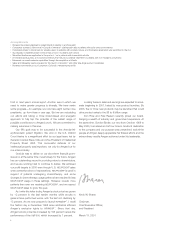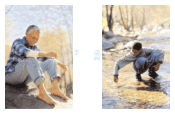Amgen 2000 Annual Report Download - page 17
Download and view the complete annual report
Please find page 17 of the 2000 Amgen annual report below. You can navigate through the pages in the report by either clicking on the pages listed below, or by using the keyword search tool below to find specific information within the annual report.
19
“As an inflammation researcher, I am convinced of the prom-
ise of a new therapy that targets and selectively blocks
interleukin-1 (IL-1). This therapy may provide improved thera-
peutic impact in RA patients whose inflamed joints produce
increased levels of this cytokine that drives the devastating
joint erosion of the disease.
The potency of therapy with Amgen’s product candidate,
anakinra, a recombinant form of naturally-occurring interleukin-
1 receptor antagonist (IL-1ra), has been consistently shown in
arthritis models. In preclinical studies, reaching sufficient levels
of IL-1ra appears to block progression of joint inflammation and
fully prevent activation of erosive enzymes, called metallopro-
teinases, and the resulting cartilage destruction. Moreover,
results from studies in RA patients suggest that treatment with
IL-1ra may reduce joint erosion.
Studies also suggest that IL-1 is more potent than another
cytokine involved in RA, TNF-α, in inducing cartilage and bone
erosion. It appears that IL-1 is a critical mediator in TNF-driven
arthritis, since IL-1 blocking appears to fully prevent TNF-
induced pathology. In addition, IL-1 production that occurs
independently of TNF-αis seen in many forms of arthritis.
Further preclinical studies also suggest that erosive arthritis
cannot be induced in IL-1 deficient mice, in contrast to findings
in TNF-deficient mice. However, spontaneous destructive
arthritis appears to occur in mice lacking IL-1 receptor antago-
nist (IL-1ra), illustrating that insufficient control of IL-1 by its
natural inhibitor, IL-1ra, causes joint destruction.
To me, this is an exciting time in the science and treatment
of rheumatoid arthritis when a significant and much needed
advance may be met by blocking the devastating erosion
caused by excess levels of IL-1 in the joints of RA patients.”
Wim B. van den Berg, PhD
Inflammation Researcher
University Medical Center
Nijmegen, The Netherlands
Synovial
membrane
Cartilage
Pannus
Synovial (joint) cavity
Capsule
Cartilage
Synovial
membrane
Pannus
Bone
TNF-α
IL-1β
Activity of IL-1βand TNF-αas proinflammatory
cytokines in rheumatoid joints.
























